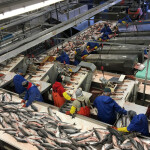Seafood seems to be way down the list of sectors attracting investors in China, as agriculture and fisheries investments accounted for just 1 percent of the USD 377 billion (EUR 335.5 billion) invested in 1,866 deals monitored by leading international mergers and acquisitions watchers Mergermarket and Merrill DatasiteOne.
Industries and chemicals accounted for 19 percent of deals in value and 24 percent in volume, topping the list of categories for deals in 2018 in a new ranking compiled by the two financial firms. The technology, media, and telecommunications [TMT] category accounted for 19 percent of value and 10 percent of volume, followed by financial services, with 13 percent and 7 percent, respectively.
Despite the U.S.-China trade war, foreign investors accounted for a record USD 49.1 billion (EUR 43.7 billion) – up 51 percent on 2017 – or 13 percent of the deals done, with nearly half that cash coming from the United States. Foreign investors appeared to be cheered by China’s pledge to lower restrictions on foreign investment into various sectors, a pledge necessitated in part by the gradual slowdown of China’s economic growth.
Keen for exposure to China’s evolving consumer market and technological innovation scene, investors have been dodging seafood. But investments in several other sectors seems likely to buoy the seafood trade. Tech and media investments include e-commerce and food distribution deals. Transport was a top five category for M&A last year (worth 9 percent of overall deal-flow) while the “consumer” category was the seventh-most popular sector for deals. The latter category covers deals in retailing and food distribution – both of which are interrelated with new distribution channels for seafood.
Investors have consistently been put off the agriculture and fisheries sector by a series of structural issues: Persistent uncertainty over land reform, as well as a relative absence of big target companies – and the fragmented nature of the primary production system – in addition to worries over disease outbreaks and natural disasters have all played a part. Meanwhile, leading seafood players like tilapia exporter Baiyang have been buying into other sectors like technology and real estate to make themselves more attractive to investors.







